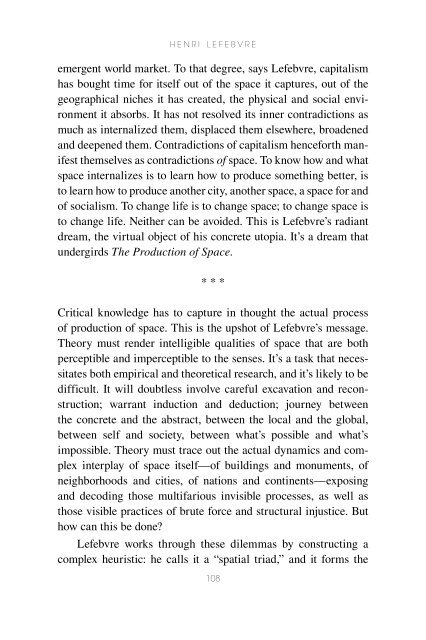Henri Lefebvre: A Critical Introduction - autonomous learning
Henri Lefebvre: A Critical Introduction - autonomous learning
Henri Lefebvre: A Critical Introduction - autonomous learning
You also want an ePaper? Increase the reach of your titles
YUMPU automatically turns print PDFs into web optimized ePapers that Google loves.
H e n r i L e F e b v r e<br />
emergent world market. To that degree, says <strong>Lefebvre</strong>, capitalism<br />
has bought time for itself out of the space it captures, out of the<br />
geographical niches it has created, the physical and social environment<br />
it absorbs. It has not resolved its inner contradictions as<br />
much as internalized them, displaced them elsewhere, broadened<br />
and deepened them. Contradictions of capitalism henceforth manifest<br />
themselves as contradictions of space. To know how and what<br />
space internalizes is to learn how to produce something better, is<br />
to learn how to produce another city, another space, a space for and<br />
of socialism. To change life is to change space; to change space is<br />
to change life. Neither can be avoided. This is <strong>Lefebvre</strong>’s radiant<br />
dream, the virtual object of his concrete utopia. It’s a dream that<br />
undergirds The Production of Space.<br />
* * *<br />
<strong>Critical</strong> knowledge has to capture in thought the actual process<br />
of production of space. This is the upshot of <strong>Lefebvre</strong>’s message.<br />
Theory must render intelligible qualities of space that are both<br />
perceptible and imperceptible to the senses. It’s a task that necessitates<br />
both empirical and theoretical research, and it’s likely to be<br />
difficult. It will doubtless involve careful excavation and reconstruction;<br />
warrant induction and deduction; journey between<br />
the concrete and the abstract, between the local and the global,<br />
between self and society, between what’s possible and what’s<br />
impossible. Theory must trace out the actual dynamics and complex<br />
interplay of space itself—of buildings and monuments, of<br />
neighborhoods and cities, of nations and continents—exposing<br />
and decoding those multifarious invisible processes, as well as<br />
those visible practices of brute force and structural injustice. But<br />
how can this be done?<br />
<strong>Lefebvre</strong> works through these dilemmas by constructing a<br />
complex heuristic: he calls it a “spatial triad,” and it forms the<br />
10
















